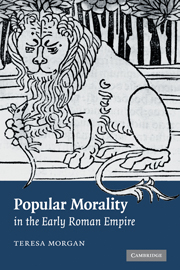Book contents
- Frontmatter
- Contents
- Preface
- List of illustrations
- List of tables
- List of abbreviations
- 1 Introduction
- PART ONE
- PART TWO
- PART THREE
- Conclusion
- Appendix 1 The political and literary connections of Babrius
- Appendix 2 The definition of a miscellany
- Appendix 3 Popular morality and philosophical doctrine
- List of papyri
- Bibliography
- Index
Appendix 2 - The definition of a miscellany
Published online by Cambridge University Press: 27 October 2009
- Frontmatter
- Contents
- Preface
- List of illustrations
- List of tables
- List of abbreviations
- 1 Introduction
- PART ONE
- PART TWO
- PART THREE
- Conclusion
- Appendix 1 The political and literary connections of Babrius
- Appendix 2 The definition of a miscellany
- Appendix 3 Popular morality and philosophical doctrine
- List of papyri
- Bibliography
- Index
Summary
A miscellany may historically be a collection of smaller works, excerpts of works, snippets of information, stories or maxims, arranged thematically, alphabetically, chronologically, randomly or in any other way. The contents may be limited – by author, genre or subject – as much or little as the compiler chooses, though before the twentieth century, a degree of thematic unity was the norm. Anthologies, encyclopaedias, companions and even dictionaries and commentaries are therefore more or less closely related to miscellanies, if not identical to them. (There is no clear dividing line between the miscellany and the anthology, but it is convenient, and intuitively appropriate to classicists, to reserve ‘anthology’ for collections of epigrams.)
There is no soi-disant ancient genre of miscellany, the nearest being satura (originally a medley of prose and/or verse compiled to be read or performed on stage, and later the genre of satire), which only covers a fraction of works which one can call miscellaneous. Those who compiled what we should call miscellanies gave them a variety of names. Aulus Gellius called his miscellany Attic Nights, describing it as commentaria, ‘notes’. Gellius reports (praef. 6–9) no fewer than thirty titles which other compilers had given to works of a similar type, of which the least picturesque include From My Reading, Problems, Handbook, Memorabilia, Things, Incidentals, Things Educational, Topics, Questions and Things Thrown Together.
- Type
- Chapter
- Information
- Popular Morality in the Early Roman Empire , pp. 331 - 332Publisher: Cambridge University PressPrint publication year: 2007



